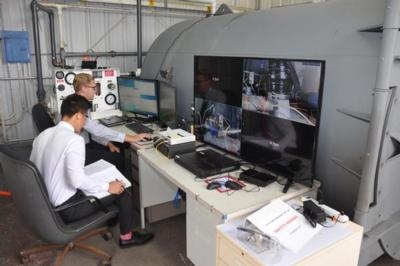Possible Problems With Cabin Pressurization Systems Are Being Examined
A group of Naval Air Systems Command (NAVAIR) engineers intend to solve a troubling and dangerous problem that has been experienced by pilots who fly all variants of the F/A-18 Hornet airframe: decompression sickness, or Physiological Events (PE).

During a PE, a pilot may experience confusion, dizziness or even the loss of consciousness due to hypoxia, or the lack of an adequate supply of oxygen. So far, more than 500 PEs including decompression sickness and hypoxia have been documented.
Kyle Zust, F/A-18 Environmental Control Systems (ECS) Cabin Pressure Test Lab (CPTL) Project Lead, suspects that problems with the airframes cabin pressurization system may be contributing to PE events.
“The inability of the cabin to maintain proper pressure has been recorded in F/A-18 A-F and EA-18G aircraft. Improper cabin pressure on the ground and during flight can result in a PE,” Zust said. “We have documented occurrences during the life cycle of this aircraft that have stated issues with cabin pressure. Approximately six years ago, the F/A-18 and EA-18G Fleet Support Team (FST) created a PE tracking system which has allowed us to gather information following a PE to investigate the occurrences.”
To test and verify cabin pressure anomalies, Zust and NAVAIR lead engineer Sean Alexander formed an engineering team in September 2016 and designed and built a testing laboratory in Buildings 486 and 487 at Fleet Readiness Center Southwest (FRCSW).
“Following a PE, we have removed ECS cabin components and sent them for investigation and have found no `smoking gun’. The purpose of the CPTL is to establish system level test capability that will enable us to determine root cause(s) and corrective action(s) to cabin pressure related PEs. The CPTL and multiple other efforts is a product of the PE tracking system,” Zust said.
Working in conjunction with the F/A-18 and EA-18G Program Office and original equipment manufacturer (OEM) Boeing through the NAVAIR F/A-18 Physiological Root Cause Corrective Action Team (RCCA), the CPTL was designed in fall of 2016, and built in the spring of 2017 by FST engineers. The facility was fully operational on Aug.18, 2017.
NAVAIR ECS branch manager Dan Cummins said that the RCCA is split into two primary groups: one that focuses on identifying the root cause(s) of the F/A-18 PEs, and the other group on implementing solutions into F/A-18 aircraft.
"RCCA is a problem-solving model that has been used by Boeing to solve complex aerospace issues on other platforms," he said. "The RCCA team is a government-private industry partnership that has representation from Boeing, Northrop Grumman, In-Service Engineering (FST), F/A-18 Aircraft Certification Engineers (ACE), PMA 265 Engineering Class Desk, as well as aeromedical experts."
“The team has begun testing on what we call `ECS Characterization Testing’. This testing gives us a measured baseline on how the ECS system performs in the F/A-18 aircraft. Follow-on testing will include fault testing and qualification testing of solutions,” Cummins said.
The test lab is comprised of three major components: A 3,400 cubic feet per minute variable speed industrial pump that generates negative pressure, or a vacuum, an accumulator, and the test chamber.
Aircraft cabin pressure components are placed in the chamber and analyzed via a closed-loop electronic control system and software developed by the NAVAIR team. A closed-loop control system uses feedback signals to make adjustments to itself.
The test chamber is compatible with all single and dual seat F/A-18 variants and has the ability to simulate an aircraft cabin environment from 0 to 50,000 feet, and climb rates exceeding 50,000 feet per minute.
“Much of the system testing being done in the CPTL cannot safely or practically be done in a manned aircraft,” Cummins noted.
At a cost of approximately $1.8 million, the lab is the only one of its kind that can test cabin pressure components on a system level. And with more than 150 hours of testing already under their belts, the F/A-18 FST has garnished valuable insight from the work already completed.
“We have gained a clearer understanding of how the F/A-18 cabin pressurization components are performing at the system level,” Cummins said. “We are currently systematically testing flight profiles to better understand the system variables that drive the system pressurization overshoots and cabin surging. We believe we are heading in the right direction.”
“By creating this lab we will gain the system level test capability that will ensure our aircrew can come home safely to their families, and also be effective down range,” Zust said.
(Image provided with NAVAIR news release)
 ANN's Daily Aero-Term (05.05.24): Omnidirectional Approach Lighting System
ANN's Daily Aero-Term (05.05.24): Omnidirectional Approach Lighting System Aero-News: Quote of the Day (05.05.24)
Aero-News: Quote of the Day (05.05.24) Airborne 05.06.24: Gone West-Dick Rutan, ICON BK Update, SpaceX EVA Suit
Airborne 05.06.24: Gone West-Dick Rutan, ICON BK Update, SpaceX EVA Suit Airborne 05.03.24: Advanced Powerplant Solutions, PRA Runway Woes, Drone Racing
Airborne 05.03.24: Advanced Powerplant Solutions, PRA Runway Woes, Drone Racing Aero-News: Quote of the Day (05.06xx.24)
Aero-News: Quote of the Day (05.06xx.24)



